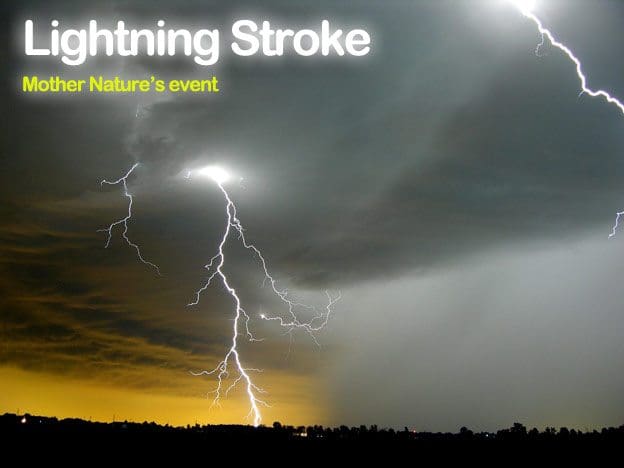
Lightning, one of Mother Nature’s most spectacular events, started to appear significantly demystified after Franklin showed its electric nature with his famous electrical kite experiment in 1752. Although a great deal of research on lightning has been conducted since then, lightning stands nowadays as a topic of considerable interest for investigation (Uman, 1969, 1987).
This is particularly true for the improved design of electric power systems, since lightning-caused interruptions and equipment damage during thunderstorms stand as the leading causes of failures in the electric utility industry.
Lightning Generation Mechanism
First Strokes
The wind updrafts and downdrafts that take place in the atmosphere, create a charging mechanism that separates electric charges, leaving negative charge at the bottom and positive charge at the top of the cloud. As charge at the bottom of the cloud keeps growing, the potential difference between cloud and ground, which is positively charged, grows as well. This process will continue until air breakdown occurs. See Fig. 10.1.
The way in which a cloud-to-ground flash develops involves a stepped leader that starts traveling downwards following a preliminary breakdown at the bottom of the cloud. This involves a positive pocket of charge, as illustrated in Fig. 10.1. The stepped leader travels downwards in steps several tens of meters in length and pulse currents of at least 1 kA in amplitude (Uman, 1969). When this leader is near ground, the potential to ground can reach values as large as 100 MV before the attachment process with one of the upward streamers is completed. Figure 10.2 illustrates a case when the downward leader is intercepted by the upward streamer developing from a tree.
It is important to highlight that the terminating point on the ground is not decided until the downward leader is some tens of meters above the ground plane and that it will be attached to one of the growing upward streamers from elevated objects such as trees, chimneys, power lines, and communication facilities.


It is actually under this principle that lightning protection rods work, i.e., they have to be strategically located so as to insure the formation of an upward streamer with a high probability of intercepting downward leaders approaching the protected area. For this to happen, upward streamers developing from protected objects within the shielded area have to compete unfavorably with those developing from the tip of the lightning rods.
Just after the attachment process takes place, the charge that is lowered from the cloud base through the leader channel is conducted to ground while a breakdown current pulse, known as the return stroke, travels upward along the channel. The return stroke velocity is around one third the speed of light. The median peak current value associated with the return stroke is reported to be on the order of 30 kA, with rise time and time to half values around 5 and 75 μs, respectively.
See Table 10.1 adapted from (Berger et al., 1975).

Associated with this charge transfer mechanism (an estimated 5 C charge is lowered to ground through the stepped leader) are the electric and magnetic field changes that can be registered at close distances from the channel and that can last several milliseconds. Sensitive equipment connected to power or telecommunication lines can get damaged when large overvoltages created via electromagnetic field coupling are developed.
Subsequent Strokes
After the negative charge from the cloud base has been transferred to ground, additional charge can be made available on the top of the channel when discharges known as J and K processes take place within the cloud (Uman, 1969). This can lead to some three to five strokes of lightning following the first stroke.
A so-called dart leader develops from the top of the channel lowering charges, typically of 1 C, until recently believed to follow the same channel of the first stroke. Studies conducted in the past few years, however, indicate that around half of all lightning discharges to earth, both single- and multiple-stroke flashes, strike ground at more than one point, with the spatial separation between the channel terminations varying from 0.3 to 7.3 km, with a geometric mean of 1.3 km (Thottappillil et al., 1992).
Generally, dart leaders develop no branching and travel downward at velocities of around 3 x 106 m/s. Subsequent return strokes have peak currents usually smaller than first strokes but faster zero-to-peak rise times. The mean inter-stroke interval is about 60 ms, although intervals as large as a few tenths of a second can be involved when a so-called continuing current flows between strokes (this happens in 25–50% of all cloud-to-ground flashes). This current, which is on the order of 100 A, is associated with charges of around 10 C and constitutes a direct transfer of charge from cloud to ground (Uman, 1969).
The percentage of single-stroke flashes presently suggested by CIGRE of 45% (Anderson and Eriksson, 1980), is considerably higher than the following figures recently obtained form experimental results: 17% in Florida (Rakov et al., 1994), 14% in New Mexico (Rakov et al., 1994), 21% in Sri Lanka (Cooray and Jayaratne, 1994) and 18% in Sweden (Cooray and Perez, 1994).











I’m working on a project for NASA and I want to know the 3 key characteristics of lightning. If you see this and respond, thank you.
If you can, can you respond to me and tell me the 3 key characteristics of lightning (its for a project) please and thank you.
Hallo, i’m seeking the permission to re-use the FIGURE 10.2 in my lightning article. is that possible ? Thank you.